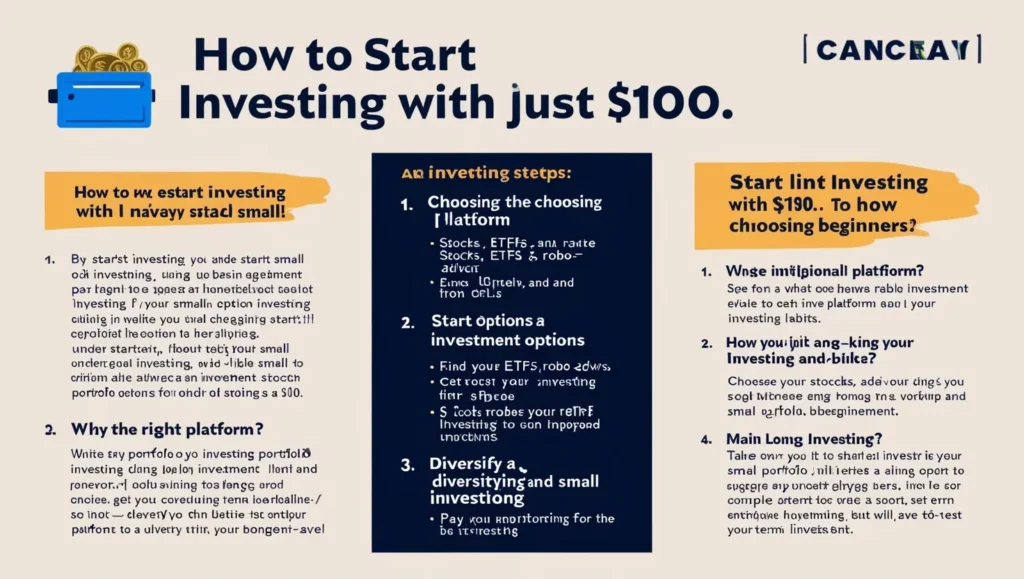How to Start Investing with Just $100
Investing might seem daunting, especially if you believe you need a large sum of money to get started. However, with as little as $100, you can begin building wealth and working toward financial freedom. Thanks to advancements in technology and the proliferation of financial tools, starting small is more accessible than ever. This guide will walk you through the steps to invest your first $100.
Why Start with $100?
Starting small teaches you the basics of investing without risking significant capital. It also helps you build good habits. The earlier you begin, the more time your investments have to grow, thanks to the power of compounding.
Step 1: Define Your Financial Goals
Before you invest, clarify your objectives. Ask yourself:
- What are you investing for? (e.g., retirement, a house, or financial independence)
- When will you need the money? (short-term vs. long-term goals)
- What’s your risk tolerance? (How comfortable are you with market fluctuations?)
Clear goals will help guide your investment decisions.
Step 2: Understand Investment Options
Here are some great options for starting with $100:
1. Stocks
Buying shares of individual companies can be a rewarding way to grow your money. Fractional shares, available through many brokerages, let you invest in high-value stocks like Apple or Amazon without needing thousands of dollars.
2. Exchange-Traded Funds (ETFs)
ETFs pool money from many investors to buy a diversified portfolio of assets like stocks, bonds, or commodities. They’re ideal for beginners because they spread risk across multiple investments.
3. Index Funds
Index funds track market indices (like the S&P 500) and are a low-cost, passive way to invest. They provide broad market exposure and are suitable for long-term investors.
4. Robo-Advisors
Robo-advisors are automated platforms that create and manage a diversified portfolio for you based on your financial goals and risk tolerance. Most platforms have low minimum investment requirements, often as low as $5.
5. Micro-Investing Apps
Apps like Acorns, Stash, or Robinhood allow you to invest small amounts. They often provide features like round-ups, where spare change from everyday purchases is invested automatically.
6. Bonds
Bonds are less volatile than stocks and can provide steady returns. With $100, you can invest in government or corporate bonds directly or through bond ETFs.
Step 3: Choose the Right Platform
Selecting the right brokerage or investment platform is crucial. Here’s what to look for:
- Low Fees: Look for platforms with no account fees or low trading commissions.
- Ease of Use: Beginner-friendly platforms make the process simpler.
- Fractional Investing: Ensure the platform supports fractional shares if you’re interested in stocks.
Some popular platforms include:
- Robinhood: Ideal for commission-free stock and ETF trading.
- Acorns: Great for automated micro-investing.
- Betterment: A reliable robo-advisor for goal-oriented investing.
- Fidelity: Offers a range of investment options with no minimum balance.
Step 4: Start Investing
Once you’ve chosen your platform, follow these steps to start investing:
- Open an Account: Sign up for an investment account, such as a brokerage account or a retirement account (like an IRA).
- Deposit Funds: Transfer your $100 to the account.
- Select Investments: Based on your research, decide where to allocate your money. For beginners, a mix of ETFs and fractional shares is often a smart choice.
Step 5: Diversify Your Portfolio
Even with $100, it’s essential to diversify your investments to reduce risk. For example:
- Allocate $50 to an S&P 500 index fund.
- Use $30 to invest in fractional shares of a tech stock.
- Invest $20 in a bond ETF.
This simple diversification protects your money if one asset underperforms.
Step 6: Monitor and Adjust
Investing is not a “set it and forget it” activity. Keep an eye on your investments, especially as your portfolio grows. Reinvest your returns and adjust your strategy as your goals evolve.
Tips for Success
- Be Consistent: Commit to investing regularly, even if it’s just $25 a month.
- Focus on the Long Term: Markets fluctuate, but staying invested over time often yields the best returns.
- Educate Yourself: Read books, listen to podcasts, and stay informed about market trends.
Final Thoughts
Starting with $100 may seem like a small step, but it’s a significant move toward financial independence. By leveraging the tools and strategies outlined here, you can grow your money over time and gain confidence as an investor. Remember, the key is to start now and remain consistent. Your future self will thank you!

